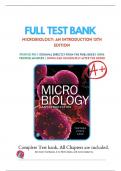Exam (elaborations)
Test Bank For Microbiology An Introduction 13th Edition by Tortora | 9780134605180 | | Chapter 1-28 |All Chapters with Answers and Rationals
Course
Microbiology, An Introduction, Tortora, 13e
Institution
Microbiology, An Introduction, Tortora, 13e
Test Bank For Microbiology An Introduction 13th Edition by Tortora | 9780134605180 | | Chapter 1-28 |All Chapters with Answers and Rationals
[Show more]
Preview 4 out of 592 pages
Uploaded on
December 11, 2024
Number of pages
592
Written in
2024/2025
Type
Exam (elaborations)
Contains
Questions & answers
Institution
Microbiology, An Introduction, Tortora, 13e
Course
Microbiology, An Introduction, Tortora, 13e
$17.99
100% satisfaction guarantee
Immediately available after payment
Both online and in PDF
No strings attached
,Test Bank Microbiology: An Introduction, 13th Edition Gerard J. Tortora




